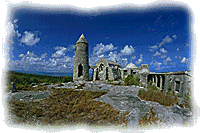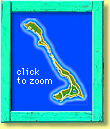T H E I S L A N D S
..................................
The "High Land" of The Bahamas
Cat Island may have derived its name from Arthur Catt, the famous British sea captain or notorious pirate (depending on whose side you were on). A competing source for the name are the hordes of wild cats that the English encountered here on arrival in the 1600s. The cats were said to be descendants of their tamer cousins orphaned by the early Spanish colonists in their rush to find the gold of South America.
 This
boot-shaped, untamed island is one of the most beautiful and fertile
of The Bahamas. A lush sanctuary, it provides tranquillity for those
seeking an escape from the pressures of modern civilization. Others
thought so too, like Father Jerome, a penitent hermit who built a
medieval monastery hewn from the limestone cliffs atop 206-foot Mt.
Alvernia, a place for meditation. From these high cliffs, there is
a marvelous view down to densely-forested foothills and 60 miles
of deserted pink-and-white-sand beach.
This
boot-shaped, untamed island is one of the most beautiful and fertile
of The Bahamas. A lush sanctuary, it provides tranquillity for those
seeking an escape from the pressures of modern civilization. Others
thought so too, like Father Jerome, a penitent hermit who built a
medieval monastery hewn from the limestone cliffs atop 206-foot Mt.
Alvernia, a place for meditation. From these high cliffs, there is
a marvelous view down to densely-forested foothills and 60 miles
of deserted pink-and-white-sand beach.
Cat Island was once home to one of the more prosperous Loyalist colonies of the Out Islands. The island gained its wealth from the numerous cotton plantations established during the 1700s. Now, vine-covered, semi-ruined mansions and stone walls from farms where cattle were penned and pineapples grown, play hide and seek within the tropical flowers, grass and sand. Crumbling remnants of slave villages and artifacts in Arawak caves whisper of a life long past. Descendants of those early settlers remain in the same towns of their ancestors.
Nature
and what "the Lord will provide" are the philosophy that
people here live by. Cat Islanders are renowned for their ingenuity
at using the materials at hand to make whatever they need. For example,
musicians combine a piece of wood, some fishing line and a worn tin
tub to create the bass instrument in a "rake 'n' scrape" band
at a local nightclub. Accompanied by a Conchshell (horn), an old
comb covered with paper (harmonica), an old carpenter's saw scraped
with a piece of metal, and topped off by a drum that really smokes
(goat skins stretched over wood and heated over a flame), Cat Island
bands produce a unique sound.
Much of The Bahamas' indigenous music, folklore and myth can be traced to Cat Island. Here, "I'll be with you in spirit" takes on a whole new meaning. Traditionally, when the last of a generation dies, his or her house is left for the spirit to live in. Remaining relatives gather stones from the site and form a new dwelling. Elsewhere, in the north of the island, residents place spindles atop houses to prevent harm from befalling them--a kind of lightning rod for evil spirits.
Copyright (c) 1995-2013 InterKnowledge Corp. All rights reserved. |
